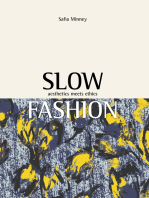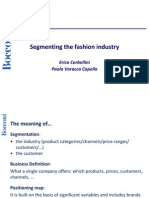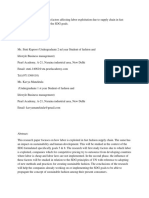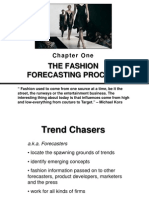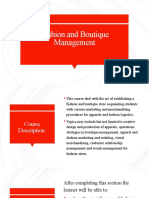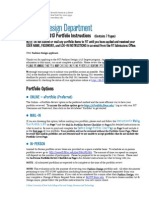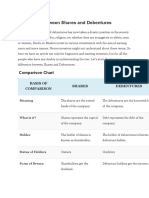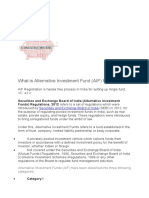Professional Documents
Culture Documents
Sustainable Fashion
Sustainable Fashion
Uploaded by
Shruti Suman100%(1)100% found this document useful (1 vote)
119 views12 pagesThis document discusses the issues with fast fashion and outlines solutions for more sustainable practices. It notes that fast fashion has led to more factory disasters as production has scaled up rapidly. While costs are rising, clothing prices are lower than ever. This system is unsustainable. The document then discusses five main issues caused by fast fashion - high water usage, hazardous chemicals, short product lifecycles, waste, and harmful agriculture practices. It promotes sustainable fashion and brands that follow principles like organic materials and longer-lasting designs.
Original Description:
sustainability in fashion industry
Original Title
SUSTAINABLE FASHION
Copyright
© © All Rights Reserved
Available Formats
PPTX, PDF, TXT or read online from Scribd
Share this document
Did you find this document useful?
Is this content inappropriate?
Report this DocumentThis document discusses the issues with fast fashion and outlines solutions for more sustainable practices. It notes that fast fashion has led to more factory disasters as production has scaled up rapidly. While costs are rising, clothing prices are lower than ever. This system is unsustainable. The document then discusses five main issues caused by fast fashion - high water usage, hazardous chemicals, short product lifecycles, waste, and harmful agriculture practices. It promotes sustainable fashion and brands that follow principles like organic materials and longer-lasting designs.
Copyright:
© All Rights Reserved
Available Formats
Download as PPTX, PDF, TXT or read online from Scribd
Download as pptx, pdf, or txt
100%(1)100% found this document useful (1 vote)
119 views12 pagesSustainable Fashion
Sustainable Fashion
Uploaded by
Shruti SumanThis document discusses the issues with fast fashion and outlines solutions for more sustainable practices. It notes that fast fashion has led to more factory disasters as production has scaled up rapidly. While costs are rising, clothing prices are lower than ever. This system is unsustainable. The document then discusses five main issues caused by fast fashion - high water usage, hazardous chemicals, short product lifecycles, waste, and harmful agriculture practices. It promotes sustainable fashion and brands that follow principles like organic materials and longer-lasting designs.
Copyright:
© All Rights Reserved
Available Formats
Download as PPTX, PDF, TXT or read online from Scribd
Download as pptx, pdf, or txt
You are on page 1of 12
• The way fashion is produced and consumed
has been dramatically scaled and sped up in
the last 20-30 years and we have seen more
frequent and deadlier factory disasters.
• For the past decade, apparel companies
have seen rising costs, driven by rising
labour, raw material and energy prices.
• Yet despite the higher cost of making
clothes, the price we pay for our clothing is
cheaper than ever before. This system isn’t
working.
ONE OF THE MAJOR CAUSES OF
ENVIRONMENTAL HARM :
FAST FASHION
• “Fast fashion” is simply a term
used by fashion retailers to
describe clothes that are inspired
by recent style trends seen on
celebrities and on the runway for
an affordable price for the average
consumer. Because of how fast
retailers need to keep up with
demands for these styles, they
often cut costs that increase their
carbon footprint.
• Pace for fashion demands to be
slowed down
• Reduce production and
consumption rate
FIVE MAIN ISSUES TO BE
ADDRESSED
• 1. Water usage: The demands for fresh water for drinking and
agriculture is far surpassing what’s available. Yes, the Earth is
covered in water, but most of it is unusable salt water or has been
polluted. As a result, some brands are now looking at the supply
chains to see how they can cut back on how much water they're
using.
• 2. Hazardous chemicals: Dyes and finishes from the production
processes are dangerous for the workers, plus they get into the
community water sources. These chemicals may not affect the
consumers, but they’re a problem for the people who make
clothing and those who live in areas where it’s produced. Fashion
and outdoor brands are now tasked with coming up with new
ways to address dyes and finishes for features like wrinkle-
resistance and water-repellency.
• 3. Short lifecycle: Stores are constantly launching new designs and
consumers are regularly updating their wardrobes. The biggest goal
in sustainable fashion is to buy less and use things longer. To make
clothes last, there are platforms for closet-sharing, brands that
promote buying used clothing, and simple yet durable styles that
you can wear over and over again.
• 4. Waste: On top of having a short lifecycle, there needs to be a way
to create less trash by making products useful again once they’ve
run their course. One way is to repair garments (i.e. mending holes
in jeans and replacing worn soles of shoes) while another
opportunity comes from using recycled materials in apparel.
• 5. Agriculture: Natural fibers like cotton are often grown using
pesticides and treatments that are harmful to the farmers, workers,
and wildlife in the area. There are now more options for organic
cotton, linen, and other fibers available, which also use less water
than the conventional growing methods. Plus, brands are looking at
being organic throughout the production process – not just the
growing of the crop, which is only the first step.
THE ANSWER TO THIS CRISIS :
SUSTAINABLE FASHION
Sustainable fashion can be defined as the
clothing, shoes and accessories that are
manufactured, marketed and used in the most
sustainable manner possible, taking into
account, both the environmental and socio-
economic aspects.
• Firstly introduced in 80s and 90s
• Mass production grew in an overwhelming way
• Concepts of organic and environmentally
friendly fabrics were introduced
• Shift was to encourage keeping pieces rather
than throwing them away
BRANDS THAT FOLLOW THE
PRINCIPLE OF SUSTAINABILITY
• Levi’S
• Alternative Apparel
• H&M Conscious
• People Tree
• Ka-Sha
• Patagonia
• Stella McCartney
• Eileen Fisher
• Uniqlo
• Doodlage
• Grassroot By Anita Dongre
THE GREEN STRATEGY
Green Strategy is an innovative and dedicated consultancy
firm that helps companies in the fashion and textile
industry develop, advance and communicate their
sustainability and circularity work more successfully.
THE CAPSULE WARDROBE:
REDUCE YOUR CLOSET TO 37 PIECES
• A capsule wardrobe is “a mini
wardrobe made up of really
versatile pieces that you totally
love to wear.” Each season
(spring, summer, fall, and
winter), you clear your closet
except for a set number of
pieces to be in your capsule
wardrobe.
• Your capsule collection is made
up of a combination of items
you already own and love to
wear, as well as new, quality
items that you can shop for
once a season.
THANK YOU
You might also like
- Jebathotta Jeyageethangal Lyrics BookDocument342 pagesJebathotta Jeyageethangal Lyrics Bookchristop96612871% (45)
- Fashion Entrepreneur Chap1Document8 pagesFashion Entrepreneur Chap1Sudeepta Saha100% (1)
- Business Plan PresentationDocument27 pagesBusiness Plan Presentationapi-542100164Noch keine Bewertungen
- Buying Eco Fabrics for Fashion Start-ups with Chris Walker: Overseas Apparel Production Series, #2From EverandBuying Eco Fabrics for Fashion Start-ups with Chris Walker: Overseas Apparel Production Series, #2Noch keine Bewertungen
- Naked Fashion: The New Sustainable Fashion RevolutionFrom EverandNaked Fashion: The New Sustainable Fashion RevolutionRating: 4.5 out of 5 stars4.5/5 (3)
- Chapter 4 Fashion CentersDocument48 pagesChapter 4 Fashion CentersJaswant Singh100% (1)
- Fashion Bird 2Document24 pagesFashion Bird 2Fashion BirdNoch keine Bewertungen
- 2 Fashion-Terminology-1Document45 pages2 Fashion-Terminology-1Niharika SharmaNoch keine Bewertungen
- Tech Pack-Uaq GCPMDocument7 pagesTech Pack-Uaq GCPMYuvraj PahujaNoch keine Bewertungen
- The Dynamics of Fashion, Third Edition: See Inside For Sample Material FromDocument43 pagesThe Dynamics of Fashion, Third Edition: See Inside For Sample Material Fromfairchildbooks100% (1)
- L3Industrysegmentation 2014Document27 pagesL3Industrysegmentation 2014albertfisher100% (1)
- Fashion ElementsDocument26 pagesFashion ElementsGoutham RiyanNoch keine Bewertungen
- Elements of Fashion: by Sunil Talekar, Faculty, SOFT-PuneDocument29 pagesElements of Fashion: by Sunil Talekar, Faculty, SOFT-PuneAnda IoanaNoch keine Bewertungen
- (Eng) Sustainable and Ethical Fashion The Environmental and Morality IssuesDocument7 pages(Eng) Sustainable and Ethical Fashion The Environmental and Morality IssuesSafira Aulia PutriNoch keine Bewertungen
- Sustainability in Supply Chain in FashionDocument7 pagesSustainability in Supply Chain in FashionStuti KapoorNoch keine Bewertungen
- Fashion: Jump To Navigation Jump To SearchDocument8 pagesFashion: Jump To Navigation Jump To SearchDamith Nishantha KarunarathnaNoch keine Bewertungen
- Presentation 1Document10 pagesPresentation 1estiakNoch keine Bewertungen
- Color BusinessDocument11 pagesColor BusinessHeba HaddadNoch keine Bewertungen
- Fashion MarketingDocument11 pagesFashion Marketingrajib_apu6772Noch keine Bewertungen
- The Direction of Fashion Change 1Document19 pagesThe Direction of Fashion Change 1Ratul HasanNoch keine Bewertungen
- Fashion Industry GuideDocument8 pagesFashion Industry GuidekeyiceNoch keine Bewertungen
- Portfolio PresentationDocument13 pagesPortfolio PresentationDivya ManivannanNoch keine Bewertungen
- Ethical Issues in FashionDocument25 pagesEthical Issues in FashionAbhināvesh ŘoyNoch keine Bewertungen
- Forecasting ProcessDocument42 pagesForecasting ProcessAjeet KumarNoch keine Bewertungen
- Fashion Forcasting 1Document45 pagesFashion Forcasting 1Spring starNoch keine Bewertungen
- Fashion BusinessDocument9 pagesFashion BusinessKrati100% (1)
- Sustainability in FashionDocument79 pagesSustainability in FashionAnitha AnithaNoch keine Bewertungen
- Fashion ForecastingDocument15 pagesFashion ForecastingTrixNoch keine Bewertungen
- Mamta Fashion PortfolioDocument41 pagesMamta Fashion PortfolioMamta ChaudharyNoch keine Bewertungen
- Design PortfolioDocument49 pagesDesign Portfoliosmitharao0% (1)
- CLASS NOTES-Fashion Product Marketing and Merchandising-UNIT 1Document60 pagesCLASS NOTES-Fashion Product Marketing and Merchandising-UNIT 1ISHITANoch keine Bewertungen
- Shape, Silhouette, Style: Focus On Design Development: Chapter ObjectivesDocument32 pagesShape, Silhouette, Style: Focus On Design Development: Chapter ObjectivesSatyam Kumar100% (4)
- Iec College of Art & Fashion: Surface OrnamentationDocument13 pagesIec College of Art & Fashion: Surface OrnamentationMahek AgrawalNoch keine Bewertungen
- Project On Fashion Related Visual Merchandising PDFDocument69 pagesProject On Fashion Related Visual Merchandising PDFAsm Towheed100% (1)
- Fashion Capitals of The WorldDocument49 pagesFashion Capitals of The WorldAvadhesh Kumar Singh100% (4)
- ET 116 - Chapter 1 - Fashion DevelopmentDocument28 pagesET 116 - Chapter 1 - Fashion DevelopmentKathlyn AragonNoch keine Bewertungen
- Fashion Forecasting ProcessDocument44 pagesFashion Forecasting ProcessStay HomeNoch keine Bewertungen
- Module I: Fashion StudiesDocument31 pagesModule I: Fashion StudiesSHUBHAM JAISWAL100% (1)
- Fashion Designer FAQDocument7 pagesFashion Designer FAQMamillapalli ChowdaryNoch keine Bewertungen
- Fashion ForecastingDocument33 pagesFashion ForecastingBhaswati PandaNoch keine Bewertungen
- FORECASTINGDocument32 pagesFORECASTINGSreedhara Akanksha0% (1)
- Creation of Conceptual Fashion Design Process ModelDocument8 pagesCreation of Conceptual Fashion Design Process ModelOtilia MihailovNoch keine Bewertungen
- Designers As TrendsettersDocument19 pagesDesigners As TrendsettersTarveen KaurNoch keine Bewertungen
- Digital Fashion & LifestyleDocument20 pagesDigital Fashion & LifestyleObinnaNoch keine Bewertungen
- Apparel Merchandising (Oe)Document8 pagesApparel Merchandising (Oe)suditi srivastavaNoch keine Bewertungen
- Social Responsibility in Fashion Industry - DR Rajesh BhedaDocument9 pagesSocial Responsibility in Fashion Industry - DR Rajesh BhedaManoj SehrawatNoch keine Bewertungen
- Product Development in The Textile - Apparel Industry - A Beginners' UnderstandingDocument4 pagesProduct Development in The Textile - Apparel Industry - A Beginners' UnderstandingDnca AlaanNoch keine Bewertungen
- List of Books Fashion DesigningDocument6 pagesList of Books Fashion DesigningShravan Kemtur100% (1)
- Active WearDocument12 pagesActive WearDeepa pangteyNoch keine Bewertungen
- UK Fashion Market ReportDocument11 pagesUK Fashion Market ReportMarukh Budhraja100% (1)
- Fashion Infographics PosterDocument3 pagesFashion Infographics PosterNasir AgbajeNoch keine Bewertungen
- Fashion Cycle and TheoriesDocument36 pagesFashion Cycle and Theoriesajay_bamel100% (2)
- FIT FashionDesign PortfolioDocument7 pagesFIT FashionDesign PortfolioUday KumarNoch keine Bewertungen
- The Fashion: Bruno Pinheiro 8ºG Nº4Document6 pagesThe Fashion: Bruno Pinheiro 8ºG Nº4Bruno PinheiroNoch keine Bewertungen
- REACH Fashion StudioDocument31 pagesREACH Fashion StudioEvy carry0% (1)
- Car Theory of Product 1Document8 pagesCar Theory of Product 1Shruti SumanNoch keine Bewertungen
- Changes in Behaviour Due To Social MediaDocument8 pagesChanges in Behaviour Due To Social MediaShruti SumanNoch keine Bewertungen
- Monopolistic Market: Submitted To: DR Rajeev Kumar Submitted By: Shruti SumanDocument9 pagesMonopolistic Market: Submitted To: DR Rajeev Kumar Submitted By: Shruti SumanShruti SumanNoch keine Bewertungen
- Leadership: and Its TheoriesDocument14 pagesLeadership: and Its TheoriesShruti SumanNoch keine Bewertungen
- Forever 21: Submitted To: Ms Vijaya TomarDocument19 pagesForever 21: Submitted To: Ms Vijaya TomarShruti SumanNoch keine Bewertungen
- Electrical System - Wiring DiagramsDocument321 pagesElectrical System - Wiring DiagramsKevin Vega BarandicaNoch keine Bewertungen
- Social Connect & Responsibility-FinelDocument3 pagesSocial Connect & Responsibility-Finelreddy1984100% (1)
- Cadangan Mendirikan Pembangunan Yang Mengandungi 241 Unit CLIENT Private Rumah Teres 2 Tingkat - Rumah Mampu Milik JohorDocument5 pagesCadangan Mendirikan Pembangunan Yang Mengandungi 241 Unit CLIENT Private Rumah Teres 2 Tingkat - Rumah Mampu Milik Johorhani sofia sulaimanNoch keine Bewertungen
- Excel Chapter - 16Document5 pagesExcel Chapter - 16Shahwaiz Bin Imran BajwaNoch keine Bewertungen
- Carabeo Vs SandiganbayanDocument2 pagesCarabeo Vs SandiganbayanVane RealizanNoch keine Bewertungen
- Difference Between Shares and DebenturesDocument4 pagesDifference Between Shares and DebenturesVinodKumarMNoch keine Bewertungen
- Clinical Chemistry: Product Selection GuideDocument16 pagesClinical Chemistry: Product Selection GuideamandafcfNoch keine Bewertungen
- Core PythonDocument53 pagesCore PythonHrik DasNoch keine Bewertungen
- Planet General Model Technical NotesDocument36 pagesPlanet General Model Technical NotesMuhammad UsmanNoch keine Bewertungen
- Tender Notice No 28 - Sillod - AurangabadDocument1 pageTender Notice No 28 - Sillod - AurangabadRanveer SalunkeNoch keine Bewertungen
- Iot Intraveous Fluid Monitoring and AlertingDocument3 pagesIot Intraveous Fluid Monitoring and AlertingAmr SaberNoch keine Bewertungen
- Monitoring Log SheetDocument1 pageMonitoring Log SheetHữu NhânNoch keine Bewertungen
- Orcad TutorDocument24 pagesOrcad Tutorsunil biradarNoch keine Bewertungen
- Chapter-3 Electronic Data Interchange (EDI)Document23 pagesChapter-3 Electronic Data Interchange (EDI)Suman BhandariNoch keine Bewertungen
- Camp Anza HistoryDocument238 pagesCamp Anza HistoryCAP History LibraryNoch keine Bewertungen
- 8D TrainingDocument33 pages8D TrainingRohan Shrivastava100% (1)
- HDFC Statement PDFDocument4 pagesHDFC Statement PDFAnonymous GR37qzswNoch keine Bewertungen
- ASHRAE Intro To LEED NC Building Commissioning EMS 30minsDocument33 pagesASHRAE Intro To LEED NC Building Commissioning EMS 30minsvictorNoch keine Bewertungen
- Gate Qes Cpu SchedulingDocument11 pagesGate Qes Cpu SchedulingVyom VermaNoch keine Bewertungen
- Unit 5 QDocument2 pagesUnit 5 Qvananhnguyenh8987Noch keine Bewertungen
- 5 6079871711837160054Document566 pages5 6079871711837160054Mehak KaushikkNoch keine Bewertungen
- Activity Guide and Evaluation Rubric. - Phase 3 - Scenario 2Document7 pagesActivity Guide and Evaluation Rubric. - Phase 3 - Scenario 2Juan Jose Rizo TrigosNoch keine Bewertungen
- Jashapara 07Document45 pagesJashapara 07Daniel Ferreira PolóniaNoch keine Bewertungen
- 4.1 Specifications 3306B Generator Set EngineDocument34 pages4.1 Specifications 3306B Generator Set Enginevalentinalg470Noch keine Bewertungen
- 21 - Eigenvalue Mode Using RitzDocument5 pages21 - Eigenvalue Mode Using RitzenatagoeNoch keine Bewertungen
- Front Office in Hotel Ramada Plaza Agra: Summer Training Project Report ONDocument6 pagesFront Office in Hotel Ramada Plaza Agra: Summer Training Project Report ONmustkeem_qureshi7089Noch keine Bewertungen
- AICE Milestone04 07.04.2024 PDFDocument15 pagesAICE Milestone04 07.04.2024 PDFsafaa el haimoudiNoch keine Bewertungen
- Alternative Investment Fund RegistrationDocument6 pagesAlternative Investment Fund RegistrationParas MittalNoch keine Bewertungen
